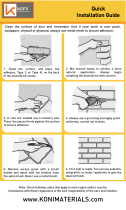TILING 09 30 00 Setting / TDS-115
Technical Chart
Property Test Method Requirement Typical Results
Pot Life 4 Hours
Open Time
(E)
A118.15
Section 5.3
E = 30
Minutes
Pass
Adjustment
Time
A118.4
Section 4.5
> 30 Minutes 45 - 50 Minutes
4 Week Shear Bond Strength
Glazed
Wall Tile
A118.15
Section 7.1.2
> 450 psi 600 - 700 psi
(42.249.2kg/cm²)
Porcelain
Tile
A118.15
Section 7.2.5
> 400 psi 400 - 500 psi
(28.135.2kg/cm²)
Quarry Tile
to Plywood
A118.11
Section 4.1.2
> 150 psi 300 - 350 psi
(21.124.6kg/cm²)
Sag on
Walls
A118.15
Section 6.0
< 0.02 mm
Environmental Consideration
Custom®BuildingProductsiscommittedtoenvironmental
responsibility in both products produced and in manufacturing
practices.UseofthisproductcancontributetowardsLEED®v3
certification:
Up to 2 points towards MR Credit 5, Regional Materials
Up to 2 points towards MR Credit 4, Recycled Content
Upto1pointtowardsIEQCredit4.1,LowEmittingMaterials–
Adhesives & Sealants
5 Instructions
General Surface Prep
Surfaces must be structurally sound. Remove all grease, oil, dirt,
curing compounds, sealers, adhesives or any other contaminant that
would prevent a good bond. Glossy or painted surfaces must be
sanded, or abraded, and stripped of all contaminants. Concrete must
be cured 28 days and accept water penetration. Concrete must be free
of efflorescence and not subject to hydrostatic pressure. Concrete
slabs should have a coarse finish to enhance the bond. Plywood
flooring including those under resilient flooring must be structurally
sound and meet all ANSI and deflection requirements. For questions
about proper subfloor installation, call Technical Services. Smooth
concrete surfaces, existing glazed tile, terrazzo, or polished stone
should be scarified. Sheet vinyl must be well bonded and stripped of
old finish. Roughen the surface by sanding or abrading, then rinse and
allow to dry. Expansion joints should never be bridged with setting
material. Do not sand flooring materials containing asbestos. Ambient
temperatureshouldbemaintainedabove50°F(10°C)orbelow100°
F(38°C)for72hourstoachieveproperbond.
Bonding to Concrete Surfaces
Concrete or plaster must be fully cured and must accept water
penetration. Test by sprinkling water on various areas of the substrate.
If water penetrates, then a good bond can be achieved; if water
beads, surface contaminants are present, and loss of adhesion may
occur. Contaminants should be mechanically removed before
installation. Concrete must be free of efflorescence and not subject to
hydrostatic pressure. Concrete slabs should have a coarse finish to
enhance the bond. Smooth concrete slabs must be mechanically
abraded to achieve proper bond.
Bonding to Lightweight Cement and Gypsum Surfaces
Lightweight or gypsum based underlayments must obtain a minimum
2000 psi (13.8 MP) compressive strength. The underlayment must be
sufficientlydryandproperlycuredtothemanufacturer’sspecifications
for permanent, non-moisture permeable coverings. Surfaces to be
tiled must be structurally sound and subject to deflection not to exceed
the current ANSI Standards. Surfaces shall be free of all grease, oil,
dirt, dust, curing compounds, waxes, sealers, efflorescence, or any
other foreign matter.
All Lightweight cement or Gypsum surfaces should be primed with a
properly applied sealer or a primer coat of RedGard, consisting of 1
part RedGard diluted with 4 parts clean, cool water. Mix in a clean
bucket at low speed to obtain a lump free solution. The primer can be
brushed, rolled or sprayed to achieve an even coat. Apply the primer
coat to the floor at a rate of 300 sq. ft.l (7.5 sq. m/L). Drying time
depends on site conditions, but is normally less than 1 hour. Extremely
porous surfaces may require 2 coats. At this point, RedGard can be
applied to the primed lightweight or gypsum based surface. Refer to
the individual product data sheet or packaging directions for application
instructions. Expansion joints must be installed in accordance with
local building codes and ANSI/TCNA guidelines. Refer to TCNA EJ171.
Bonding to Plywood Surfaces
Plywood floors, including those under resilient flooring, must be
structurally sound and must meet all ANSI A108.01 Part 3.4
requirements. Maximum allowable deflection: L/360 tile L/720 stone.
See TCNA F150-13 Tile Installations, TCNA F141-13 and F250-13 for
Stone. For questions about proper subfloor installation requirements,
call Custom technical services.
Bonding to Backerboards
As an alternative to an additional layer of plywood, WonderBoard
backerboard may be installed over plywood subfloors for ceramic tile
installations. Refer to TCNA F144-13 tile installations, TCNA F250-13
stone installations. Call Custom technical services when installing
natural stone over plywood subfloor.
Bonding to Existing Surfacing Material
Existing Ceramic Tile, Resilient Flooring or Plastic Laminates: Resilient
flooring or plastic laminates must be well bonded, as well as clean and
free of all contaminates. Roughen the surface by sanding or scarifying;
rinse and allow to dry. Do not sand flooring that contains asbestos. For
existing well bonded ceramic tile, mechanically abrade the surface.
Rinse and allow to dry. When sanding, an approved respirator should
be used.
Bonding to Cutback Adhesive
Adhesive layers must be removed, as they reduce mortar bond
strength to cement surfaces. Use extreme caution; adhesives may
contain asbestos fibers. Do not sand or grind adhesive residue, as
harmful dust may result. Never use adhesive removers or solvents, as
they soften the adhesive and may cause it to penetrate into the
concrete. Adhesive residue must be wet scraped to the finished
surface of the concrete, leaving only the transparent staining from the
glue. To determine desirable results, do a test bond area before
starting.RefertotheRFCIPamphlet,“RecommendedWorkPractices
forRemovalofResilientFloorCoverings”forfurtherinformation.
FlexBond®CrackPreventionMortar
Published Date: 1/31/2014












